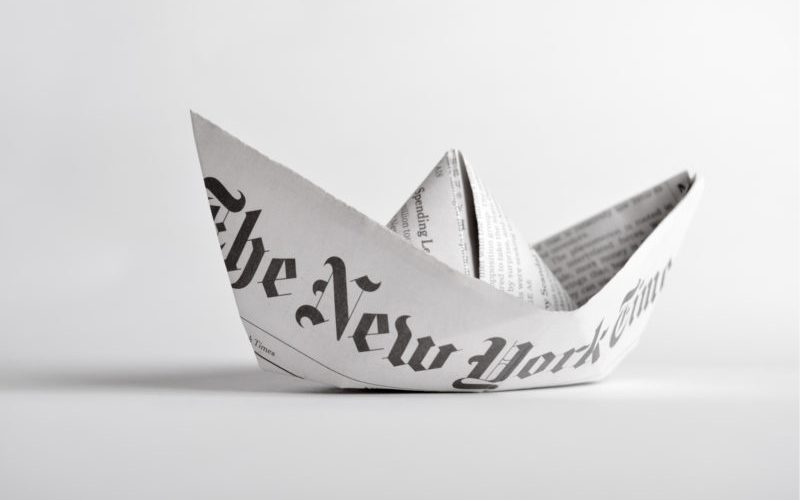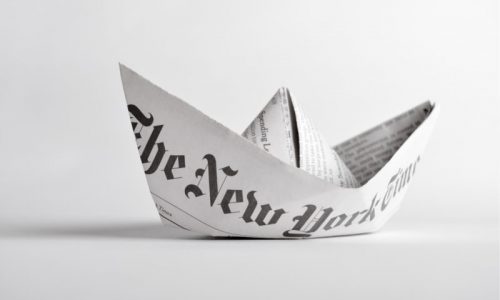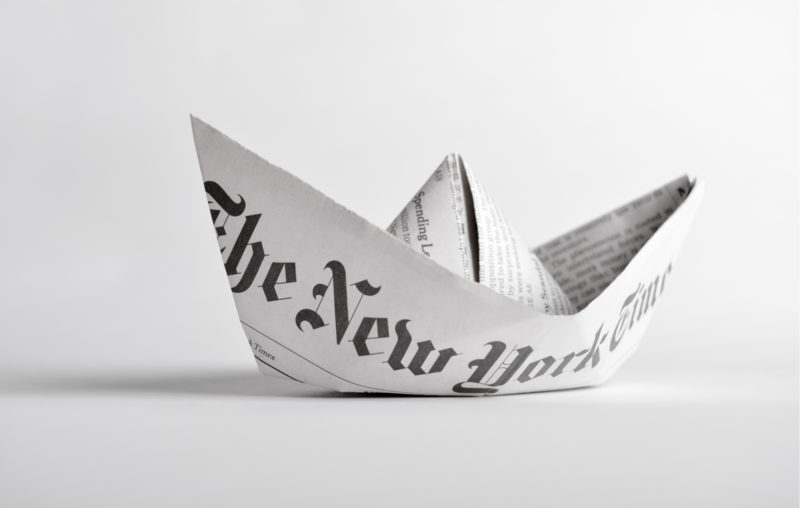
Why Does the New York Times Brazenly Deny the Obvious?


Don’t laugh derisively, as people do these days, but I’ve always admired the New York Times. First draft of history. Talent everywhere. Best production values. Even with its ideological spin, it can be scrupulous about facts. You can usually extract the truth with a decoder ring. Its outsized influence over the rest of the press makes it essential. I’ve relied on it for years. Even given everything, and I mean everything.
Until now. It’s just too much. Too much unreality, manipulation, propaganda, and flat out untruths that are immediately recognizable to anyone. I can’t believe they think they can get away with this with credibility intact. I’m not speaking of the many great reporters, technicians, editors, production specialists, and the tens of thousands who make it all possible. I’m speaking of a very small coterie of people who stand guard over the paper’s editorial mission of the moment and enforce it on the whole company, with no dissent allowed.
Let’s get right to the offending passage. It’s not from the news or opinion section but the official editorial section and hence the official voice of the paper. The paragraph from June 2, 2020, reads as follows.
Healing the wounds ripped open in recent days and months will not be easy. The pandemic has made Americans fearful of their neighbors, cut them off from their communities of faith, shut their outlets for exercise and recreation and culture and learning. Worst of all, it has separated Americans from their own livelihoods.
Can you imagine? The pandemic is the cause!
I would otherwise feel silly to have to point this out but for the utter absurdity of the claim. The pandemic didn’t do this. It caused a temporary and mostly media-fueled panic that distracted officials from doing what they should have done, which is protect the vulnerable and otherwise let society function and medical workers deal with disease.
Instead, the CDC and governors around the country, at the urging of bad computer-science models uninformed by any experience in viruses, shut down schools, churches, events, restaurants, gyms, theaters, sports, and further instructed people to stay in their homes, enforced sometimes even by SWAT teams. Jewish funerals were broken up by the police.
It was brutal and egregious and it threw 40 million people out of work and bankrupted countless businesses. Nothing this terrible was attempted even during the Black Death. Maximum economic damage; minimum health advantages. It’s not even possible to find evidence that the lockdowns saved lives at all.
But to hear the New York Times tell the story, it was not the lockdown but the pandemic that did this. That’s a level of ideological subterfuge that is almost impossible for a sane person to conjure up, simply because it is so obviously unbelievable.
It’s lockdown denialism.
Why? From February 2020 and following, the New York Times had a story and they are continuing to stick to it. The story is that we are all going to die from this pandemic unless government shuts down society. It was a drum this paper beat every day.
Consider what the top virus reporter Donald J. McNeil (B.A. Rhetoric, University of California, Berkeley) wrote on February 28, 2020, weeks before there was any talk of shutdowns in the U.S.:
There are two ways to fight epidemics: the medieval and the modern.
The modern way is to surrender to the power of the pathogens: Acknowledge that they are unstoppable and to try to soften the blow with 20th-century inventions, including new vaccines, antibiotics, hospital ventilators and thermal cameras searching for people with fevers.
The medieval way, inherited from the era of the Black Death, is brutal: Close the borders, quarantine the ships, pen terrified citizens up inside their poisoned cities.
For the first time in more than a century, the world has chosen to confront a new and terrifying virus with the iron fist instead of the latex glove.
And yes, he recommends the medieval way. The article continues on to praise China’s response and Cuba’s to AIDS and says that this approach is natural to Trump and should be done in the United States. (AIER called him out on this alarming column on March 4, 20202.)
McNeil then went on to greater fame with a series of shocking podcasts for the NYT that put a voice and even more panic to the failed modeling of Neil Ferguson of the Imperial College London.
This first appeared the day before his op-ed calling for global lockdown. The transcript includes this:
I spend a lot of time thinking about whether I’m being too alarmist or whether I’m being not alarmist enough. And this is alarmist, but I think right now, it’s justified. This one reminds me of what I have read about the 1918 Spanish influenza.
Reminder: 675,000 Americans died in that pandemic. There were only 103 million people living in the U.S. at the time.
He continues:
I’m trying to bring a sense that if things don’t change, a lot of us might die. If you have 300 relatively close friends and acquaintances, six of them would die in a 2.5 percent mortality situation.
That’s an astonishing claim that seems to forecast 8.25 million Americans will die. So far as I know, that is the most extreme claim made by anyone, four times as high as the Imperial College model.
What should we do to prevent this?
You can’t leave. You can’t see your families. All the flights are canceled. All the trains are canceled. All the highways are closed. You’re going to stay in there. And you’re locked in with a deadly disease. We can do it.
So because this coronavirus “reminds” him of one he read about, he can say on the air that four million people could soon die, and therefore life itself should be cancelled. Because a reporter is “reminded” of something.
This is the same newspaper that in 1957 urged people to stay calm during the Asian flu and trust medical providers – running all of one editorial on the topic. What a change! This was an amazing podcast — amazingly irresponsible.
McNeil was not finished yet. He was at it again on March 12, 2020, demanding that we not just close big events and schools but shut down everything and everyone “for months.” He went back on the podcast twice more, then started riding the media circuit, including NPR. It was also the same. China did it right. We need to lock down or people you know, if you are one of the lucky survivors, will die.
To say that the New York Times was invested in the scenario of “lock down or we die” is an understatement. It was as invested in this narrative as it was in the Russia-collaboration story or the Ukrainian-phone call impeachment, tales to which they dedicated hundreds of stories and many dozens of reporters. The virus was the third pitch to achieve their objective.
Once in, there was no turning back, even after it became obvious that for the vast numbers of people this was hardly a disease at all, and that most of the deaths came from one city and mostly from nursing homes that were forced by law to take in COVID-19 patients.
That the newspaper, a once venerable institution, has something to answer for is apparent. But instead of accepting moral culpability for having created a panic to fuel the overthrow of the American way of life, they turn on a dime to celebrate people who are not socially distancing in the streets to protest police brutality.
To me, the protests on the streets were a welcome relief from the vicious lockdowns. To the New York Times, it seems like the lockdowns never happened. Down the Orwellian memory hole.
In this paper’s consistent editorializing, nothing is the fault of the lockdowns. Everything instead is the fault of Trump, who “tends to see only political opportunity in public fear and anger, as in his customary manner of contributing heat rather than light to the confrontations between protesters and authority.”
True about Trump but let us remember that the McNeil’s first pro-lockdown article praised Trump as perfectly suited to bring about the lockdown, and the paper urged him to do just that, while only three months later washing their hands of the whole thing, as if had nothing to do with current sufferings much less the rage on the streets.
And the rapid turnaround of this paper on street protests was stunning to behold. A month ago, people protesting lockdowns were written about as vicious disease spreaders who were denying good science. In the blink of an eye, the protesters against police brutality (the same police who enforced the lockdown) were transmogrified into bold embracers of First Amendment rights who posed no threat to public health.
Not even the scary warnings about the coming “second wave” were enough to stop the paper from throwing out all its concern over “targeted layered containment” and “social distancing” in order to celebrate protests in the streets that they like.
And they ask themselves why people are incredulous toward mainstream media today.
The lockdowns wrecked the fundamentals of life in America. The New York Times today wants to pretend they either didn’t happen, happened only in a limited way, or were just minor public health measures that worked beautifully to mitigate disease. And instead of having an editorial meltdown over these absurdities, preposterous forecasts, and extreme panic mongering that contributed to vast carnage, we seen an internal revolt over the publishing of a Tom Cotton editorial, a dispute over politics not facts.
The record is there: this paper went all in back in February to demand the most authoritarian possible response to a virus about which we already knew enough back then to observe that this was nothing like the Spanish flu of 1918. They pretended otherwise, probably for ideological reasons, most likely.
It was not the pandemic that blew up our lives, commercial networks, and health systems. It was the response to the virus that did that. The Times needs to learn that it cannot construct a fake version of reality just to avoid responsibility for what they’ve done. Are we really supposed to believe what they write now and in the future? This time, I hope, people will be smart and learn to consider the source.